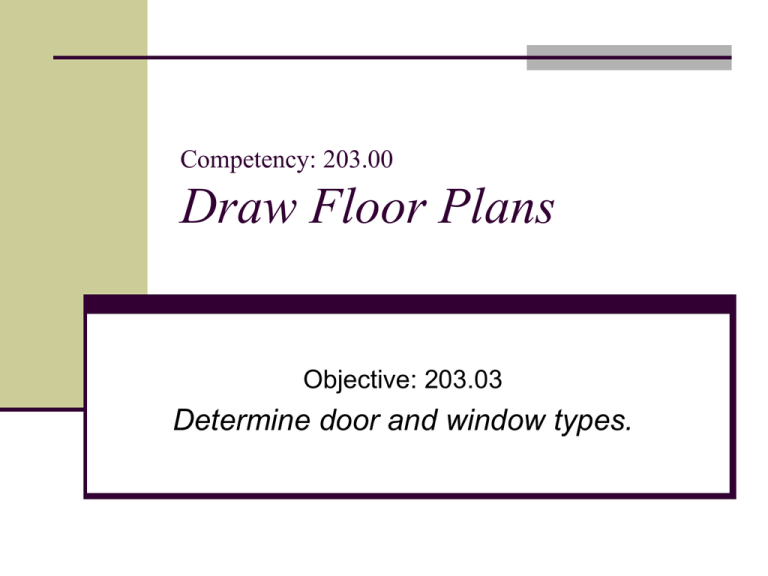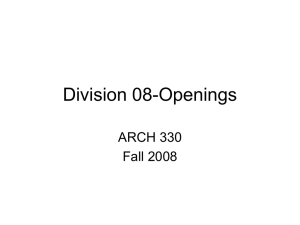203.03 Doors & Windows
advertisement

Competency: 203.00 Draw Floor Plans Objective: 203.03 Determine door and window types. Doors General Classifications Flush doors Smooth on both sides Mahogany or birch plywood Panel doors Heavy frame around perimeter Parts Stiles Rails Panels Louvers Exterior Doors Typical sizes 6’-8” tall by 1-3/4” thick Entry door minimum 3’-0” Insulated Sloping sills to shed water Exterior Doors Swinging doors Hinged Swing into the house Sliding doors Wood or metal frames Tempered glass Access to deck/patio Common widths 6’-0” 8’-0” French doors Mullions and muntins between glass panes One large glass panes Individual, pairs, groups Garage doors Overhead One piece or sectional Widths Singles: 8’, 9’, 10’ Doubles: 15’,16’, 18’ Height generally 7’-0” Interior Doors Standard sizes Height: 6’-8” Thickness: 1-3/8” Width: Varies based on 2” module Standard widths Entry: Bedrooms: Baths: Closets: 3’-0” 2’-6” 2’-0” or 2’-4” As large as possible Interior Doors Bi-fold Set of two doors make up one unit Hung on a track Popular for closets Sliding/Bypass Hung on a track Popular for closets Used in wide openings Interior Doors Pocket doors Hung on a track Slides into a wall cavity Frees floor space Packaged with framed pocket Double-action Spring hinge mounted Swings two ways One or two doors Windows Purpose Admits light Provides fresh air and ventilation Adds detail, balance, interest Visually enlarges interior space Window Types Double-hung Two sashes slide up and down Most commonly used Horizontal sliding/gliding Two or more sashes slide horizontally Operates on a track Casement Hinged sashes; outward swing Window Types Awning Sash hinged on top; swings outward Allows open unit during rain Hopper Hinged sash on bottom; swings inward Allows for unusual shapes Fixed Do not open Combined with other windows Window Types Bay and Bow Fixed or casement Project from structure Bay windows offer traditional style Sides drawn @ 450 or 300 Depth between 18” and 24” Roof structure Bow windows are in a circular pattern Skylights Built into roof Admit light Door/Window Schedules Marks placed on floor plan identify doors & windows Numbers or letters inside circles or polygons identify individual units Placed close to door & window symbols Same mark used for doors/windows with same size and characteristics Door/Window Schedules Arrange all information about doors and windows in a chart Repeat marks on floor plans List number of doors/windows List size of individual and multiple units Identify types Includes material notes and special remarks May include elevation drawings near chart











